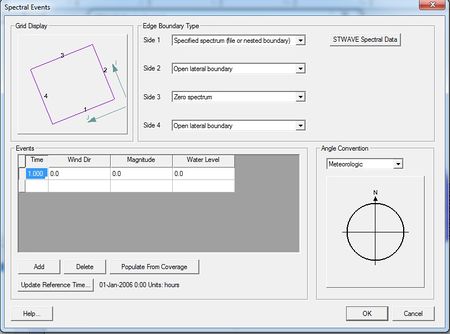SMS:Spectral Events: Difference between revisions
No edit summary |
No edit summary |
||
| Line 1: | Line 1: | ||
[[File:SpectralEvents.jpg|thumb|450 px|'' | [[File:SpectralEvents.jpg|thumb|450 px|''Spectral Events'' dialog]] | ||
The external boundary condition for STWAVE consists of one or more energy spectra entering on one or more open edges of the grid. The '' | The external boundary condition for STWAVE consists of one or more energy spectra entering on one or more open edges of the grid. The ''Spectral Events'' dialog specifies the STWAVE boundary conditions and locations of these boundary conditions. This dialog is reached through the ''STWAVE Model Control'' dialog. | ||
==Grid Display== | ==Grid Display== | ||
Revision as of 19:02, 13 January 2014
The external boundary condition for STWAVE consists of one or more energy spectra entering on one or more open edges of the grid. The Spectral Events dialog specifies the STWAVE boundary conditions and locations of these boundary conditions. This dialog is reached through the STWAVE Model Control dialog.
Grid Display
This graphic shows the orientation of the grid and labels the sides of the grids which is used in other controls within the dialog.
Edge Boundary Type
The type of boundary condition applied to each edge of the STWAVE grid is shown and in some cases edited in this section of the dialog.
The types of boundary conditions include:
- Specified spectrum – This may come from a parent grid if using nesting. Otherwise, a button to the right will be used to assign the spectral coverage to the boundary.
- 1D transformed spectrum – This boundary type allows energy to propagate along the boundary without interference. The cells would have the same energy if the grid was extended and the boundary became interior to a larger grid.
- Zero spectrum – The boundary doesn't have any spectral energy applied.
For half-plane models, the boundary condition types are fixed and energy travels in the positive I direction of the grid. In this case, the user specifies spectra that will be introduced at side 1. Sides 2 and 4 will be treated as 1D transformed spectra.
For full-plane models, the boundary condition types may be specified. You cannot have specified spectra on two adjacent boundaries. Therefore, you can have specified spectra on a maximum of two boundaries and these must be on opposite boundaries.
Events Spreadsheet
This spreadsheet defines the time step or cases that will be used and the input boundary conditions for each. SMS is setup so that you can reuse the same spectral information for multiple time steps or cases.
The first column is the case name or the time step value depending upon whether or not the simulation is using time steps. If time steps are not used, the id for the cases can be any alpha-numeric text so long as it does not contain a comma(,) or slash(/)anywhere in the text. However, if time steps are used, then the case id must be an integer number. When time steps are used, the number represents how much later the time is. Hence, if 5 is entered for the case id, and the time units is hours, then it is the case of 5 hours later. When nesting is used, the case ids, and the number of cases, will be determined by the parent simulation. When the parent simulation is a WAM run, then time steps with a reference time must be used.
In addition to the external condition, the engine can simulate distributed forces over the domain including wind, surge and currents. The currents applied to a simulation are specified in the model control dialog. Wind and surge values are specified in the spread sheet in columns 2 through 4.
If you are not using nesting, there will be one or two columns on the end to represent input spectra (two columns will only show up if two boundaries have specified spectrum boundary types). These columns are used to specify which of the spectra to use for each case or time step. The spectra must be generated previously using the Spectral Energy Dialog. You can specify the spectra to use for a time-step or case by selecting the cell in the spreadsheet and then double clicking on the appropriate spectra entry in the energy spectra tree.
The number and use of the remaining columns in the spreadsheet will depend upon the options used for the STWAVE simulation. For example, if a constant value is used for wind and/or surge columns will appear that represent the wind direction, magnitude and/or tidal elevation as applicable.
Energy Spectra
The energy spectra group box contains controls to specify which spectra data to use for each case/time step as described above. The tree represents the active spectral grid and its associated dataset. You can go the spectral energy dialog by clicking on the spectral energy button. Here you can change the active spectral grid and/or create new spectral grids and datasets.
Angle Convention
The angle convention controls allow you to choose the convention that will be used for the wind direction field in the events spreadsheet. The direction represented by the wind angle of the active row of the spreadsheet is plotted on the direction graph.
| [hide] SMS – Surface-water Modeling System | ||
|---|---|---|
| Modules: | 1D Grid • Cartesian Grid • Curvilinear Grid • GIS • Map • Mesh • Particle • Quadtree • Raster • Scatter • UGrid |  |
| General Models: | 3D Structure • FVCOM • Generic • PTM | |
| Coastal Models: | ADCIRC • BOUSS-2D • CGWAVE • CMS-Flow • CMS-Wave • GenCade • STWAVE • WAM | |
| Riverine/Estuarine Models: | AdH • HEC-RAS • HYDRO AS-2D • RMA2 • RMA4 • SRH-2D • TUFLOW • TUFLOW FV | |
| Aquaveo • SMS Tutorials • SMS Workflows | ||
